Oh look, it’s that time of year again. No, not Christmas time (though it’s that also), but the time to reflect and recount on the previous year’s ups and downs. And this year there were plenty of both. From freak snowstorms and wayward hurricanes to genre-defining anime and a plethora of new games on which to whet one’s appetite, 2011 was nothing if not eventful, no matter what you might have been looking for. So let’s take a look at some of the year’s highlights and things best-left-avoided.
The Good:
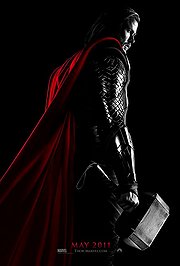 Marvel Superhero Movies: 2011 was a good year for action-driven superheroes. Especially those in the Marvel stable. I will admit that I had very low expectations for Captain America, and prayed they wouldn’t screw up Thor. And thankfully, I was wrong on both accounts. 2011 had plenty of Iron Mans, with no Iron Man 2s to sully the field. Thor was amazing, with an excellent cast, striking visual effects and a compelling plot. (In a Marvel film, that’s a real achievement honestly.) X-Men First Class threw out everything we knew about the franchise and managed to reboot from the god-awful “Last Stand.” But the true highlight of the year was “Captain America.” Hokey outfit aside (which they dealt with rather well, actually), the film got us ready for 2012’s “Avengers,” and took viewers on a trip back through World War II, without sacrificing its entertainment potential. Less a set-up film, more an in-depth origin story, and a wonderful addition to the Marvel filmography.
Marvel Superhero Movies: 2011 was a good year for action-driven superheroes. Especially those in the Marvel stable. I will admit that I had very low expectations for Captain America, and prayed they wouldn’t screw up Thor. And thankfully, I was wrong on both accounts. 2011 had plenty of Iron Mans, with no Iron Man 2s to sully the field. Thor was amazing, with an excellent cast, striking visual effects and a compelling plot. (In a Marvel film, that’s a real achievement honestly.) X-Men First Class threw out everything we knew about the franchise and managed to reboot from the god-awful “Last Stand.” But the true highlight of the year was “Captain America.” Hokey outfit aside (which they dealt with rather well, actually), the film got us ready for 2012’s “Avengers,” and took viewers on a trip back through World War II, without sacrificing its entertainment potential. Less a set-up film, more an in-depth origin story, and a wonderful addition to the Marvel filmography.
 Mid-Atlantic Anime Cons: I have been known to sing the praises of Anime Boston, and a lot of the New England conventions, for their diverse programming and attendees. This year, the mid-Atlantic entered that fray in force. From February’s Katsucon hitting stride in National Harbor (it’s still the best “weekend con” I’ve ever been to), to Anime Mid Atlantic’s family-friendly summer party, to Nekocon’s progress in quality programming, and Anime USA’s last hurrah in Crystal City, 2011 gave the mid-Atlantic some truly memorable experiences, enough that it would be hard to choose which convention to attend. But fortunately, given that they are held in a relatively small area, staggered throughout the year, one doesn’t have to. If you’re looking for something new, away from the hustle of Otakon, or want to find a friendly, intimate convention experience, give the mid-Atlantic a try. You will not be disappointed.
Mid-Atlantic Anime Cons: I have been known to sing the praises of Anime Boston, and a lot of the New England conventions, for their diverse programming and attendees. This year, the mid-Atlantic entered that fray in force. From February’s Katsucon hitting stride in National Harbor (it’s still the best “weekend con” I’ve ever been to), to Anime Mid Atlantic’s family-friendly summer party, to Nekocon’s progress in quality programming, and Anime USA’s last hurrah in Crystal City, 2011 gave the mid-Atlantic some truly memorable experiences, enough that it would be hard to choose which convention to attend. But fortunately, given that they are held in a relatively small area, staggered throughout the year, one doesn’t have to. If you’re looking for something new, away from the hustle of Otakon, or want to find a friendly, intimate convention experience, give the mid-Atlantic a try. You will not be disappointed.
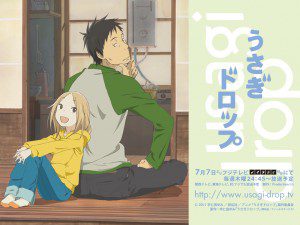 Usagi Drop: Given the predominance of action-heavy, moe-dominated anime series floating around, sometimes a nice, grounded, realistic series is a welcome breath of fresh air. The Summer 2011 entry “Usagi Drop,” based on the popular manga of the same name, is one such series. No flashy, supernatural heroes. No mecha. No lolicons or schoolgirls. Just a simple, refreshing series about a man and his “daughter,” a girl born to his late father, and their journey through an often chaotic life. Maturity, family values, adaptability, responsibility and good old-fashioned comfort are the rules of this day. And it’s worth every minute.
Usagi Drop: Given the predominance of action-heavy, moe-dominated anime series floating around, sometimes a nice, grounded, realistic series is a welcome breath of fresh air. The Summer 2011 entry “Usagi Drop,” based on the popular manga of the same name, is one such series. No flashy, supernatural heroes. No mecha. No lolicons or schoolgirls. Just a simple, refreshing series about a man and his “daughter,” a girl born to his late father, and their journey through an often chaotic life. Maturity, family values, adaptability, responsibility and good old-fashioned comfort are the rules of this day. And it’s worth every minute.
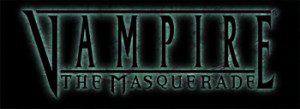 Two Decades of Vampires: 2011 marked the 20th Anniversary of Mark Rein-Hagen’s landmark RPG “Vampire: The Masquerade.” While the setting was rebooted a few years back, many fans of the original game still held strong ties to the political machinations of the warring vampire clans, and the general melding of gothic, cyberpunk and urban horror that first graced the game world in the early 90s, when fantasy dungeon-diving was still the de facto experience for gamers. Vampire brought an entire new culture into roleplaying, switching the emphasis from dice rolls to personal interaction. Rather than a collection of statistics and combat equations, Vampire stressed crafting a finely tunes, well rounded CHARACTER, who had to survive in a modern world where EVERYTHING wanted to kill them. Fights with orcs transformed into power struggles with opposing clans, and the monsters lurking in the dark were still capable of falling prey to other monsters lurking even further into the darkness. White Wold Game Studio commemorated this event with the release of the “Vampire 20th Anniversary Edition,” a massive, 500+ page tome collecting every clan, bloodline, supernatural power, morality path, character merit/flaw for the first time in one place, and gave fans a limited window to snag a copy. But if you have $100 lying around (likely more now that the print run has ended), and you’ve yet to experience this level of in-depth roleplaying, go out and find a copy. It will be well worth your time.
Two Decades of Vampires: 2011 marked the 20th Anniversary of Mark Rein-Hagen’s landmark RPG “Vampire: The Masquerade.” While the setting was rebooted a few years back, many fans of the original game still held strong ties to the political machinations of the warring vampire clans, and the general melding of gothic, cyberpunk and urban horror that first graced the game world in the early 90s, when fantasy dungeon-diving was still the de facto experience for gamers. Vampire brought an entire new culture into roleplaying, switching the emphasis from dice rolls to personal interaction. Rather than a collection of statistics and combat equations, Vampire stressed crafting a finely tunes, well rounded CHARACTER, who had to survive in a modern world where EVERYTHING wanted to kill them. Fights with orcs transformed into power struggles with opposing clans, and the monsters lurking in the dark were still capable of falling prey to other monsters lurking even further into the darkness. White Wold Game Studio commemorated this event with the release of the “Vampire 20th Anniversary Edition,” a massive, 500+ page tome collecting every clan, bloodline, supernatural power, morality path, character merit/flaw for the first time in one place, and gave fans a limited window to snag a copy. But if you have $100 lying around (likely more now that the print run has ended), and you’ve yet to experience this level of in-depth roleplaying, go out and find a copy. It will be well worth your time.
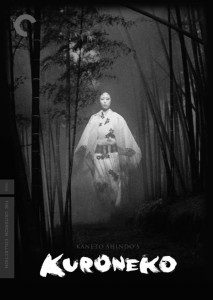 Criterion Collection Releases “Kuroneko,” Acquires Rights to “Gojira:” Unless you are a fan of Japanese art-house cinema, the former film might be completely unknown to you. (And if you are a fan, you probably already own it in some form.) But in October 2011, the Criterion Collection, already known for giving fans of early J-horror their fix, finally released a remastered edition of the horror classic “Kuroneko,” a story of betrayal, revenge, honor, and ghost cats. And for those who had never managed to track down a copy from its VHS release (including yours truly), this was a fantastic release. The other great “ghost cat” film (the first being the irreverent Hausu), Kuroneko is a character study in folklore and the samurai, bringing to light the dark side of both, and well worth the price, given that the last time this film saw a stateside release, it was the 80s, and art-house Japan was still truly an underground phenomenon.
Criterion Collection Releases “Kuroneko,” Acquires Rights to “Gojira:” Unless you are a fan of Japanese art-house cinema, the former film might be completely unknown to you. (And if you are a fan, you probably already own it in some form.) But in October 2011, the Criterion Collection, already known for giving fans of early J-horror their fix, finally released a remastered edition of the horror classic “Kuroneko,” a story of betrayal, revenge, honor, and ghost cats. And for those who had never managed to track down a copy from its VHS release (including yours truly), this was a fantastic release. The other great “ghost cat” film (the first being the irreverent Hausu), Kuroneko is a character study in folklore and the samurai, bringing to light the dark side of both, and well worth the price, given that the last time this film saw a stateside release, it was the 80s, and art-house Japan was still truly an underground phenomenon.
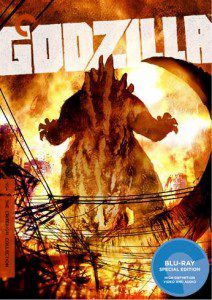 The latter film, however, should be very familiar to US audiences. After years of re-releases by original producer Toho, now Criterion has the chance to once more introduce us to the ravages of nuclear war, overconsumption, and giant, radiation breathing dinosaurs. While Criterion Godzilla won’t be around until February or March, fans will no doubt be eagerly anticipating what kind of treatment will be bestowed upon this kaiju classic.
The latter film, however, should be very familiar to US audiences. After years of re-releases by original producer Toho, now Criterion has the chance to once more introduce us to the ravages of nuclear war, overconsumption, and giant, radiation breathing dinosaurs. While Criterion Godzilla won’t be around until February or March, fans will no doubt be eagerly anticipating what kind of treatment will be bestowed upon this kaiju classic.
Kaizoku Sentai Gokaiger: Super Sentai series aren’t exactly known for their riveting plots and developed characters. What they often are is over the top excursions into action and adventure, with “giant robots” and spandex suits. But in honor of the 35th anniversary of the ongoing sentai serials in Japan, viewers were treated to an even more gratuitous exploitation of young adults, space aliens, rubber suits, and men in oversized robot outfits. Kaizoku Sentai Gokaiger managed to do what no other sentai had ever even tried- it brought together every single sentai series into a single entity. And it did it with PIRATES. (Sorry Ninjas, but you lose…with authority.)
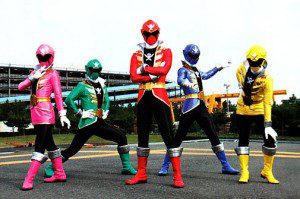 Forget Power Rangers, forget zords, funky weapons and stock footage- Gokaiger is at the same time a celebration of previous sentai entertainment, and a new beginning. Every rule broken, every battle a crazy mess, every feasible type of hero present and accounted for- this is what sentai was meant to be, and finally is. Given our 2 year lag behind Japan in this area, we won’t see Mighty Morphin Pirate Rangers until 2013, but in the meantime, check it out online. And prepare to be blown away.
Forget Power Rangers, forget zords, funky weapons and stock footage- Gokaiger is at the same time a celebration of previous sentai entertainment, and a new beginning. Every rule broken, every battle a crazy mess, every feasible type of hero present and accounted for- this is what sentai was meant to be, and finally is. Given our 2 year lag behind Japan in this area, we won’t see Mighty Morphin Pirate Rangers until 2013, but in the meantime, check it out online. And prepare to be blown away.
Up Next: Remake Extravaganza, Fantasy Fever, and Mindf**king

